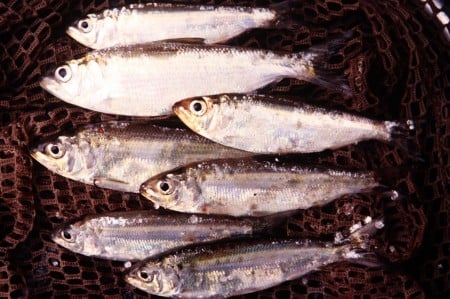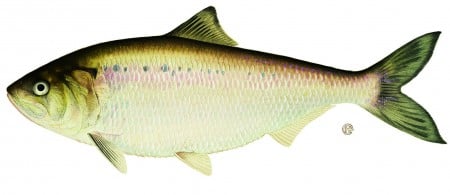They treat our fish like trash. Help us stop them.

River herring from the Hudson River (Photo courtesy Tom Lake)
View more images on our Flickr site
Don’t let the NOAA Fisheries Service weaken crucial reforms for industrial fishing fleets that treat the Hudson’s fish like trash. Send your comment now! The deadline for comments is Thursday, July 18.
Please use our sample letter below to guide you. Send your letter by cutting, pasting and personalizing the letter into a document on your computer, then uploading it by clicking here. (Note that there is a word count limitation in the box marked “Type Comment,” so please copy the text to a document on your computer, than upload the file if submitting online.) You may also fax to (978) 281-9135, Attn: Carrie Nordeen or mail to John K. Bullard, Regional Administrator, NMFS, Northeast Regional Office, 55 Great Republic Drive, Gloucester, MA 01930. Mark the outside of the envelope, “Comments on the Herring Amendment 5 Proposed Rule.”
Protecting the Hudson River’s fish doesn’t stop at New York Harbor. We have to send a message to the Fisheries Service that reforming Atlantic herring fishing regulations in New England is critical to the recovery of the Hudson River ecosystem.
Since the 1990s, industrial trawlers started catching Atlantic herring, decimating our river herring, including American shad, which spawn in the Hudson’s upriver shallows and tributaries, but live much of their adult lives along the Atlantic coast between Florida and Nova Scotia. Some of the Hudson’s most important and storied species are tossed overboard as “bycatch” – garbage, in other words. (Atlantic herring are also an important food source for Hudson River predators like striped bass, making them an important part of the Hudson River ecosystem.)
How bad are these trawlers for our fish? A quarter of a million river herring have been caught in a single tow of a midwater trawler’s net—enough to “obliterate an entire river’s population of fish,” according to Greg Wells, of the Pew Charitable Trusts.
Hudson River shad, the largest river herring, were once a staple of working waterfronts and river communities, as the spring migration brought abundant food to the nets of fishermen from Manhattan to Troy. The fishery was closed in 2010, after the fish endured decades of overfishing on the spawning grounds, choking sewage pollution, devastating loss of habitat, competition from invasive species – and mismanagement of ocean fisheries that rapidly depleted the stressed stocks. Today, several East Coast states have banned fishing for blueback herring and alewives (collectively known as “river herring”), and New York this year enacted new restrictions to better protect them from overfishing on the Hudson.
River herring should be so abundant they make up an important base of the food web, but they are so depleted that they have been proposed for protection under the Endangered Species Act.
It doesn’t have to be this way.
We can’t let our hard work protecting and restoring Hudson River habitats, regulating fishing and reducing pollution go to waste. Help us prevent bycatch from decimating shad and other river herring in the Atlantic, where industrial trawlers catch hundreds of millions of pounds of Atlantic herring, and untold numbers of river herring “bycatch.”
Last year, thanks in part to tens of thousands of comments from people like you, regional fishery managers voted for fisheries reforms, including 100 percent at-sea catch monitoring by certified observers and limits on indiscriminate dumping of uninspected catch at sea.
We need your voice to win final approval and implementation of this new management system.
Take action now! Write to NOAA’s Northeast administrator, John Bullard, and tell him to reform the Atlantic herring fishery to protect the Hudson River ecosystem.
Please use our sample letter below to guide you. Send your letter by cutting, pasting and personalizing the letter into a document on your computer, then uploading it by clicking here. (Note that there is a word count limitation in the box marked “Type Comment,” so please copy the text to a document on your computer, than upload the file if submitting online.) You may also fax to (978) 281-9135, Attn: Carrie Nordeen or mail to John K. Bullard, Regional Administrator, NMFS, Northeast Regional Office, 55 Great Republic Drive, Gloucester, MA 01930. Mark the outside of the envelope, “Comments on the Herring Amendment 5 Proposed Rule.”
DRAFT LETTER
Dear Administrator Bullard:
I am writing to urge your agency to approve Amendment 5 to the Atlantic Herring Fishery Management Plan and to implement the proposed regulatory changes as quickly as possible.
These reforms are critical to the recovery of the Hudson River, where American shad and other river herring are important to the ecosystem, culture and economy of our region. Bycatch for river herring and shad should be tightly regulated to allow these depleted stocks to recover.
• River herring and American shad populations are at historic and dramatic lows, with populations having declined by 99 and 97 percent respectively. The Atlantic State Marine Fishery Commision’s (ASFMC) recently released stock assessment for river herring found that alewife and blueback herring along East Coast are “depleted,” with many populations in a dangerously diminished state. The ASMFC’s stock assessment for American shad found its populations to be highly depressed from historical levels and not recovering.
• According to the ASMFC’s 2012 stock assessment, at-sea fisheries are a significant factor in the decline of river herring populations over the last 50 years. In some years, more than 2 million pounds of river herring are killed incidentally by at-sea fisheries.
• The industrial Atlantic herring fishery is a serious threat to these already depleted species. NMFS observer data show that a quarter of a million river herring have been caught in a single tow of a midwater trawler’s net, far more fish than return to many of New England’s rivers each year to spawn. If the fish are aggregated while at sea, a single haul could obliterate an entire river’s population of fish.
In June 2012, tens of thousands of citizens, including commercial and recreational fishermen, coastal business owners, and conservation organizations, asked the New England Fishery Management Council to adopt a strong set of reforms for the herring fishery to protect ocean ecosystems and coastal communities. The council responded, voting to adopt a strong set of improvements.
I am concerned that NOAA Fisheries is now considering rejecting several priority reforms for this fishery. Amendment 5 is necessary to effectively conserve and manage New England’s Atlantic herring population and those species taken as bycatch. This action would strengthen the region’s ocean ecosystem and coastal communities.
In particular, NOAA should approve the following key measures:
— Address river herring and shad bycatch: NOAA Fisheries must honor the Council’s commitment to develop a catch cap for river herring and shad as quickly as possible. The cap is the only regulatory measure in the amendment that would meet NOAA’s legal obligation to minimize bycatch of these important and depleted species.
— Implement 100 percent observer coverage: Placement of an observer on every herring trawler is justified because of the fleet’s fishing power and its demonstrated capacity for bycatch of already depleted river herring and shad, marine mammals, bluefin tuna, and groundfish such as haddock. Although efforts to limit the industry’s share of the costs of observer coverage are understandable, the council was clear that the industry should pay what is necessary to ensure 100 percent coverage is achieved, and this is essential to making this measure work. I urge you to quickly implement this program and honor the council’s objective to have an observer on every midwater trawl vessel.
— Reduce wasteful slippage, or dumping of catch: Caps on the deliberate release of fish before they are brought onboard (”slippage”) and the requirement that fishing trips be terminated if catch is slipped after the cap is reached, are critical to effective catch monitoring and bycatch estimation in this fishery. The Amendment 5 draft environmental impact statement shows that the caps are carefully designed using existing data and are set at levels that provide the fleet with ample opportunity to avoid trip termination, yet still provide safeguards against unlimited dumping.
— Ensure accurate weighing of catch: NOAA Fisheries should approve the requirement that federally-permitted herring dealers accurately weigh all fish, ending the practice of visual estimates of catch weight. This requirement, in combination with the 100 percent observer coverage, would result in better catch estimates and help ensure that limits are not exceeded.
— Requirements for trawlers in groundfish closed areas: The agency must approve measures requiring fishermen to notify NOAA Fisheries of their intent to fish in a closed area, to comply with the sampling rules currently required in Closed Area I, and to have 100 percent observer coverage on all midwater trawl vessels fishing in the year-round groundfish closed areas. The Council’s clear intention was to allow midwater trawlers into these areas only with a NOAA Fisheries-approved observer on board, and to grant no waivers.
Thank you for the opportunity to share my concerns. Please consider these comments in your decision to approve Amendment 5.

